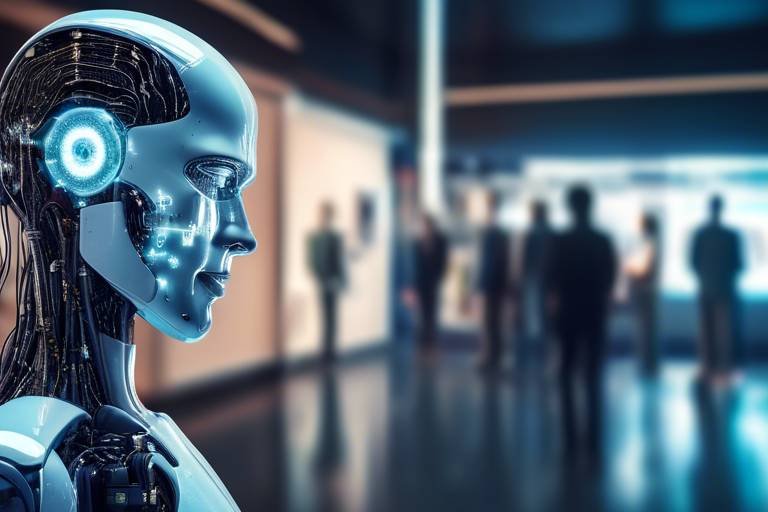The Role of Artificial Intelligence in Personal Safety
In today's rapidly evolving world, artificial intelligence (AI) is becoming a cornerstone of personal safety. Imagine walking down the street, feeling an invisible shield around you, thanks to the latest in AI technology. It’s not just a dream; it’s becoming a reality. From smart surveillance systems that can recognize faces in a crowd to wearable devices that monitor your health and alert you in emergencies, AI is reshaping how we think about safety. But what does this mean for individuals and communities? How can we harness these technologies responsibly while ensuring our privacy and ethical standards are upheld?
AI enhances personal safety through innovative technologies that not only protect but also empower individuals. For instance, consider the role of AI in surveillance systems. These systems are no longer just about recording footage; they utilize advanced algorithms to detect unusual behavior, alerting authorities before an incident escalates. This proactive approach can significantly reduce crime rates and enhance community safety. But it's not just about public spaces; our homes are becoming fortresses with the integration of AI into smart home security solutions. Imagine receiving an alert on your phone while you're at work, letting you know that someone is at your door. This level of connectivity is revolutionizing how we protect our personal spaces.
As we delve deeper, the implications of AI in personal safety extend beyond mere convenience. Take facial recognition technology, for instance. This powerful tool is being used in various settings, from airports to retail stores, to identify individuals and enhance security measures. However, it also raises significant questions about privacy and the potential for bias in its application. It’s a double-edged sword that necessitates a careful balance between security and individual rights. In this context, discussions around ethical implications are crucial. How do we ensure that the benefits of such technologies do not come at the cost of our fundamental freedoms?
Moreover, the use of AI in law enforcement is generating considerable debate. While it aids in identifying suspects and enhancing public safety, it also raises concerns about the effectiveness of these technologies and their potential misuse. The concept of predictive policing—using AI to analyze crime data and anticipate criminal activity—is a prime example of how data-driven approaches can improve resource allocation. However, this too must be approached with caution to avoid reinforcing existing biases within the justice system.
In addition to surveillance and law enforcement, AI is making strides in the realm of wearable safety devices. These gadgets, equipped with AI capabilities, are designed to empower users by providing features like emergency alerts and health monitoring. Imagine wearing a device that not only tracks your fitness but can also detect anomalies in your heart rate and alert you to potential health crises. This intersection of health and safety is a game changer, allowing individuals to take control of their well-being in real-time.
As we look to the future, the role of AI in personal safety is poised to grow even more significant. With advancements in technology, we can expect even more sophisticated solutions that not only enhance security measures but also improve user experience. However, this progress must be tempered with an ongoing dialogue about ethical challenges, ensuring that our pursuit of safety does not infringe upon our rights and freedoms.
- How does AI improve personal safety?
AI enhances personal safety through advanced surveillance systems, smart home security, and wearable devices that monitor health and alert users in emergencies. - What are the ethical concerns regarding AI in personal safety?
Key concerns include privacy invasion, potential bias in facial recognition, and the balance between security and individual rights. - Can AI help in health monitoring?
Yes, AI-driven wearables can detect health anomalies and alert users, enabling timely interventions for personal safety. - What is predictive policing?
Predictive policing uses AI to analyze crime data to anticipate criminal activities and allocate law enforcement resources effectively.

AI-Powered Surveillance Systems
In today's world, the concept of safety has taken on a new dimension, thanks in large part to the advent of . These systems are not just about watching over us; they are about enhancing our security in ways that were once thought to be the stuff of science fiction. Imagine a world where every corner is monitored by intelligent cameras that can recognize faces, detect unusual behavior, and alert authorities in real-time. This is no longer a distant dream; it's a reality that is transforming our cities and homes.
AI-driven surveillance systems utilize advanced technologies such as facial recognition and anomaly detection to significantly improve monitoring capabilities. For instance, when a camera equipped with AI technology scans a crowded area, it can instantly identify individuals based on a database of known faces. This capability is particularly useful in public spaces like airports, where security is paramount. But it doesn't stop there; these systems can also flag unusual activities, such as someone loitering in a restricted area or a sudden surge of people in a typically quiet location. By doing so, they provide law enforcement and security personnel with actionable insights that can prevent incidents before they escalate.
However, the implementation of AI surveillance systems is not without controversy. The very technologies that enhance our safety also raise questions about privacy and ethical considerations. For example, how much surveillance is too much? Are we sacrificing our privacy for the sake of safety? These are critical questions that society must grapple with as we integrate AI into our security frameworks.
To illustrate the impact of AI in surveillance, consider the following table that outlines some key features and benefits of AI-powered surveillance systems:
| Feature | Benefit |
|---|---|
| Facial Recognition | Quick identification of individuals, enhancing security in public spaces. |
| Anomaly Detection | Alerts security personnel to unusual behavior, potentially preventing crimes. |
| Real-Time Monitoring | Immediate response capabilities, improving overall safety. |
| Data Analytics | Provides insights into crime trends, helping law enforcement allocate resources effectively. |
As we embrace these technologies, it's essential to strike a balance between security and privacy. Regulations and guidelines must evolve to ensure that while we harness the power of AI for surveillance, we also protect individual rights. Engaging in community discussions and policy-making can lead to responsible usage that benefits everyone.
In conclusion, AI-powered surveillance systems are reshaping the landscape of personal safety. They offer unprecedented capabilities that can deter crime and enhance security, but they also challenge us to consider the implications of constant monitoring. As we move forward, the conversation about how to implement these technologies ethically will be crucial in ensuring a safer yet respectful environment for all.

Smart Home Security Solutions
In today's fast-paced world, the concept of home security has taken a giant leap forward, thanks to the advent of . These innovative technologies are designed to offer homeowners peace of mind by integrating advanced features that go beyond traditional locks and alarms. Imagine being able to monitor your home from anywhere in the world, receiving instant alerts about potential threats, and even controlling your security system with just your voice. Sounds like something out of a sci-fi movie, right? But it's very much a reality today!
Smart home security solutions leverage artificial intelligence to provide an array of functionalities that enhance safety. For instance, automated alerts keep you informed of any unusual activities, whether it's a door left ajar or motion detected in your backyard. These alerts can be sent directly to your smartphone, allowing you to take immediate action, such as contacting the authorities or checking in via your home security cameras.
Moreover, the integration of smart technologies means that your home security can work in harmony with other devices. For example, if your security camera detects movement, it can trigger your smart lights to turn on, illuminating the area and potentially deterring intruders. This interconnectedness not only enhances security but also adds to the convenience of managing your home environment. Imagine walking into a well-lit home after a long day, all thanks to your smart security system!
One of the standout features of smart home security solutions is remote monitoring. With a simple tap on your smartphone, you can access live feeds from your security cameras, check the status of your doors and windows, and even communicate with visitors at your door through smart doorbells. This level of control is empowering, providing you with the ability to respond to situations in real-time, no matter where you are. It's like having a personal security guard at your beck and call!
However, while the benefits are substantial, it's essential to consider the implications of incorporating AI into your home security. The reliance on technology raises questions about privacy and data security. For instance, how safe is the data collected by these devices? Are there safeguards in place to protect your personal information from cyber threats? These are crucial considerations that every homeowner should address before fully diving into the world of smart home security.
In conclusion, smart home security solutions are not just a trend; they are a vital aspect of modern living that enhances personal safety. By combining AI with smart technology, homeowners can create a more secure environment that is responsive, convenient, and tailored to their needs. As we move forward, it will be fascinating to see how these technologies evolve and continue to shape the landscape of home security.
- What are smart home security solutions?
Smart home security solutions refer to integrated devices and systems that use technology to enhance home security, including alarms, cameras, and smart locks. - How do AI features improve home security?
AI features improve home security by providing real-time monitoring, automated alerts, and the ability to analyze data for suspicious activities. - Are smart home security systems safe?
While they offer enhanced security, it's crucial to ensure that the devices are well-secured against cyber threats and that user data is protected.

Facial Recognition Technology
Facial recognition technology is a groundbreaking application of artificial intelligence that has transformed the way we think about security and identification. By utilizing complex algorithms, this technology can analyze and identify human faces with remarkable accuracy. Imagine walking through an airport, and the system instantly recognizes your face, allowing for a seamless check-in process. This is not just science fiction; it's happening right now! However, while the advantages are evident, the implications of such technology raise important questions about privacy and ethics.
At its core, facial recognition technology operates by capturing an image of a person's face and comparing it to a database of known faces. This process involves several steps:
- Image Capture: A camera captures the facial image in real-time.
- Feature Extraction: The system identifies key facial features, such as the distance between the eyes, the shape of the jawline, and the contour of the lips.
- Comparison: The extracted features are then compared to those in a database to find a match.
These systems are increasingly deployed in various settings, including airports, shopping malls, and even public streets, serving as a deterrent to potential criminals. For instance, in retail environments, facial recognition can help identify known shoplifters, thereby enhancing the security measures in place. However, this raises a significant concern: what happens to the data collected? Are individuals aware that their faces are being scanned and stored?
Moreover, while the technology offers a layer of security, it also poses ethical dilemmas, particularly regarding privacy. The potential for misuse is substantial, leading to discussions about the need for regulations governing its use. As society grapples with these issues, it is crucial to strike a balance between leveraging technology for safety and protecting individual rights.
In conclusion, facial recognition technology stands at the forefront of security innovation, providing enhanced safety measures across various sectors. Yet, as we embrace these advancements, we must remain vigilant about the ethical implications and ensure that the technology is used responsibly. The conversation surrounding facial recognition is ongoing, and it is vital for stakeholders to engage in discussions that shape its future.

Ethical Implications of Facial Recognition
The emergence of facial recognition technology has undoubtedly transformed the landscape of security and surveillance. However, with great power comes great responsibility, and the ethical implications surrounding this technology are profound. One of the primary concerns is the issue of privacy invasion. As facial recognition systems become more prevalent, individuals may find themselves constantly monitored, leading to a significant erosion of personal privacy. Imagine walking down the street and knowing that your every move is being tracked and recorded. This can create a chilling effect on personal freedom and expression.
Moreover, the potential for bias in facial recognition algorithms raises serious ethical questions. Studies have shown that these systems can misidentify individuals, particularly among marginalized groups. This bias can result in wrongful accusations, discrimination, and an overall lack of trust in law enforcement. For instance, if a facial recognition system is less accurate for people of color, it could lead to a disproportionate number of false positives, further entrenching systemic inequalities in society.
To navigate these ethical waters, it is crucial to engage in discussions about regulations and responsible usage. Policymakers, technologists, and civil rights advocates must collaborate to develop frameworks that ensure facial recognition technology is used ethically and transparently. This could involve implementing strict guidelines on how data is collected, used, and stored. Additionally, organizations should be held accountable for any misuse or abuse of this technology.
In conclusion, while facial recognition technology holds the promise of enhancing security, it is imperative to address its ethical implications. Balancing the benefits of increased safety with the fundamental rights of individuals requires a thoughtful and inclusive approach. As we move forward, society must prioritize ethical considerations to ensure that technological advancements do not come at the expense of personal freedoms.
- What are the main ethical concerns surrounding facial recognition technology?
The primary concerns include privacy invasion, potential bias in algorithm accuracy, and the need for regulations to ensure responsible usage. - How can bias in facial recognition systems be addressed?
Addressing bias involves improving algorithm training data, ongoing evaluation of system performance across different demographics, and implementing accountability measures for misuse. - What role do regulations play in the use of facial recognition technology?
Regulations are crucial in establishing guidelines for data collection, usage, and storage, ensuring that individuals' rights are protected while allowing for the benefits of the technology.

Applications in Law Enforcement
In recent years, the integration of facial recognition technology and other AI-driven tools in law enforcement has transformed the way authorities approach public safety. By leveraging sophisticated algorithms, law enforcement agencies can now identify suspects with remarkable accuracy, streamlining the investigation process significantly. Imagine a scenario where a crime occurs, and within minutes, officers can use AI to analyze surveillance footage, match faces, and potentially identify the perpetrator. This capability not only enhances the efficiency of investigations but also serves as a deterrent for potential criminals who know that advanced technology is monitoring their actions.
However, the application of AI in law enforcement is not without its challenges. While the technology promises to improve public safety, it also raises critical questions about privacy and ethical use. For instance, who has access to the data collected? How is it stored? These questions become even more pressing when considering the potential for bias in AI algorithms, which can lead to disproportionate targeting of specific demographics. Therefore, it is essential to strike a balance between utilizing these technologies for public safety and ensuring that individual rights are protected.
The adoption of AI in law enforcement can be categorized into several key applications:
- Real-Time Monitoring: AI systems can analyze live feeds from surveillance cameras, alerting officers to unusual activities as they happen.
- Data Analysis: AI can sift through vast amounts of data from various sources, helping law enforcement identify crime trends and hotspots.
- Community Engagement: AI tools can assist in developing strategies that involve community input, fostering trust between law enforcement and citizens.
As we look toward the future, it is clear that the role of AI in law enforcement will continue to evolve. Agencies are investing in training and resources to ensure that officers are equipped to use these technologies effectively and ethically. Collaboration with tech companies and civil rights organizations is also becoming increasingly important, as these partnerships can help establish guidelines and standards for responsible AI usage in policing. Ultimately, the goal is to harness the power of AI to create safer communities while safeguarding the rights of individuals.
- What are the main benefits of using AI in law enforcement? AI enhances efficiency in investigations, improves public safety, and helps identify crime trends.
- Are there any risks associated with facial recognition technology? Yes, there are concerns regarding privacy, potential bias, and the misuse of data.
- How can law enforcement agencies ensure ethical use of AI? By collaborating with civil rights organizations and establishing clear guidelines for data usage and privacy protection.

Predictive Policing
Predictive policing is a groundbreaking approach that utilizes artificial intelligence to analyze vast amounts of crime data. Imagine having a crystal ball that helps law enforcement agencies foresee potential criminal activities before they happen. This innovative technology examines patterns, trends, and historical data to identify hotspots where crimes are likely to occur. By leveraging this information, police departments can allocate resources more efficiently, deploying officers to areas in need of heightened surveillance and intervention.
At its core, predictive policing operates on the principle of data-driven decision-making. It combines statistical analysis with advanced algorithms to interpret data from various sources, including past crime reports, social media activity, and even environmental factors. For example, if a particular neighborhood has seen a spike in burglaries during summer months, AI can flag this information, allowing law enforcement to take proactive measures. This could mean increasing patrols in that area or engaging with community members to enhance neighborhood watch programs.
However, while the benefits of predictive policing are significant, it also raises several concerns. One of the most pressing issues is the potential for bias in the algorithms used. If the data fed into these systems contains historical biases, the predictions generated could unfairly target certain communities. This has sparked debates about the ethical implications of using AI in law enforcement. As we navigate this complex landscape, it’s crucial to ensure that predictive policing enhances safety without infringing on individual rights.
Moreover, the effectiveness of predictive policing is still a topic of discussion. Critics argue that it can lead to over-policing in specific areas, creating a cycle of mistrust between communities and law enforcement. Advocates, on the other hand, emphasize that when implemented responsibly, predictive policing can significantly reduce crime rates and improve community relations. The key lies in transparent practices and community involvement.
As technology continues to evolve, the future of predictive policing looks promising. With advancements in machine learning and data analytics, we can expect even more precise predictions and effective crime prevention strategies. However, it will be essential to strike a balance between utilizing these powerful tools and protecting the rights of individuals within our communities.
- What is predictive policing? Predictive policing is a method that uses artificial intelligence to analyze crime data and anticipate where crimes are likely to occur.
- How does predictive policing work? It analyzes historical crime data, patterns, and various factors to predict future criminal activities, allowing law enforcement to allocate resources effectively.
- What are the ethical concerns surrounding predictive policing? Concerns include potential biases in data leading to unfair targeting of communities and the risk of over-policing.
- Can predictive policing reduce crime rates? When implemented responsibly, predictive policing has the potential to reduce crime rates by allowing proactive measures to be taken.

Wearable Safety Devices
In today's fast-paced world, personal safety has become a paramount concern for individuals everywhere. Enter , which have emerged as a game-changer in the realm of personal security. These innovative gadgets, ranging from smartwatches to personal alarms, are designed to keep you safe while seamlessly integrating into your daily life. Imagine having a personal safety assistant right on your wrist or in your pocket—sounds amazing, right? With the power of artificial intelligence (AI), these devices are not just ordinary wearables; they are smart companions that can alert you to dangers and even call for help when you need it most.
One of the most significant advantages of wearable safety devices is their emergency response features. Many of these devices come equipped with a panic button or an SOS feature that allows users to alert authorities or loved ones in critical situations. For instance, if you're out for a jog and feel threatened, a simple press of a button can send your location and an emergency alert to your contacts or local law enforcement. This capability significantly improves response times, potentially making a life-saving difference.
Moreover, wearable devices often incorporate advanced health monitoring features that contribute to personal safety. These devices can track vital signs such as heart rate and blood pressure, and some even have the ability to detect falls or other health anomalies. When a concerning trend is detected, the device can send alerts to the user or designated contacts, ensuring timely intervention. For example, if a senior citizen wearing a health-monitoring device experiences a sudden drop in heart rate, the device can automatically alert emergency services, providing peace of mind to both the individual and their family.
Let's take a closer look at some popular types of wearable safety devices:
| Device Type | Key Features | Benefits |
|---|---|---|
| Smartwatches | Health tracking, emergency alerts, GPS | Multi-functional, discreet, and always connected |
| Personal Alarms | Noise activation, GPS tracking | Immediate attention in emergencies, portable |
| Fitness Trackers | Heart rate monitor, fall detection | Encourages an active lifestyle while ensuring safety |
As technology continues to evolve, the future of wearable safety devices looks incredibly promising. With advancements in AI, we can expect even more sophisticated features that will enhance personal safety. Imagine a device that not only alerts you in emergencies but also analyzes your surroundings for potential threats. The integration of AI could lead to predictive capabilities, allowing these devices to anticipate dangerous situations before they occur.
However, as with any technology, there are challenges to address. Privacy concerns regarding data collection and usage are at the forefront of discussions about wearable safety devices. Manufacturers must ensure that user data is protected and that individuals have control over their information. This balance between safety and privacy will be crucial as these devices become more prevalent in our lives.
In conclusion, wearable safety devices are transforming the way we think about personal security. With their ability to provide immediate assistance and monitor health, these devices empower individuals to take charge of their safety. As we move forward, the integration of AI will only enhance their capabilities, making them indispensable tools in our quest for a safer environment.
- What are wearable safety devices?
Wearable safety devices are gadgets that you can wear on your body, such as smartwatches or personal alarms, designed to enhance your safety through features like emergency alerts and health monitoring. - How do wearable safety devices work?
These devices utilize sensors and AI technology to monitor your health and surroundings, sending alerts or notifications in case of emergencies. - Are wearable safety devices effective?
Yes, they can significantly improve personal safety by offering immediate assistance and monitoring health, potentially saving lives in critical situations. - What should I consider when choosing a wearable safety device?
Consider the features that are most important to you, such as emergency response capabilities, health monitoring, battery life, and privacy policies.

Emergency Response Features
In today's fast-paced world, the need for personal safety has never been more critical, and this is where wearable devices with emergency response features come into play. Imagine having a small gadget on your wrist that can instantly alert authorities in a crisis. This isn't just a dream—it's a reality made possible by advancements in technology. These devices are designed to provide peace of mind, ensuring that help is just a button press away.
Many modern wearables are equipped with features that allow users to send out emergency alerts with a simple tap. For example, if you're in a precarious situation, such as being followed or feeling threatened, you can activate the emergency function without drawing attention to yourself. This is a game-changer, especially for individuals who may feel vulnerable in certain situations. The ability to connect directly with emergency services can significantly improve response times, potentially saving lives.
Moreover, these devices often come with GPS capabilities, allowing responders to locate you quickly. This is especially crucial in scenarios where every second counts. Imagine a situation where you're lost or incapacitated; a wearable device can transmit your location to emergency personnel, ensuring they can reach you without delay. This integration of technology not only enhances personal safety but also builds a sense of community trust in these innovations.
Additionally, many wearables are now incorporating health monitoring features that can also trigger emergency alerts. For instance, if a device detects a sudden drop in heart rate or an abnormal health condition, it can automatically notify emergency contacts or services. This proactive approach to safety means that not only are you protected from external threats, but your health is also being monitored, creating a comprehensive safety net.
However, while these features are incredibly beneficial, it’s essential to understand the underlying technology and privacy implications. Users should be aware of how their data is used and stored. The balance between safety and privacy is a conversation that needs to be ongoing as technology continues to evolve.
In summary, the emergence of wearable devices with emergency response features represents a significant leap forward in personal safety technology. They empower individuals by providing immediate access to help and enhancing overall security. As we continue to embrace these innovations, the future of personal safety looks brighter than ever.
- What types of emergency response features are available in wearable devices?
Many wearable devices offer features such as SOS alerts, location tracking, and health monitoring that can trigger emergency notifications.
- How do these devices ensure my privacy?
Most reputable manufacturers implement strict data protection measures, but it's essential to read privacy policies and understand how your data will be used.
- Can I customize the emergency contacts on my device?
Yes, most devices allow users to set and customize emergency contacts that will be notified in case of an emergency.
- Are these devices effective in real emergency situations?
Yes, they can significantly improve response times and provide crucial information to emergency services, but effectiveness may vary based on the device and location.

Health Monitoring and Safety
In today's fast-paced world, the importance of personal safety cannot be overstated, especially when it comes to health. With the advent of AI-driven health monitoring devices, individuals are now better equipped to manage their well-being and respond to potential health crises. These devices, often worn on the wrist or embedded in clothing, continuously track vital signs such as heart rate, blood pressure, and even oxygen levels. Imagine having a personal health assistant that never sleeps, always alert and ready to notify you of any irregularities!
One of the most remarkable features of these AI-enabled wearables is their ability to detect anomalies in real-time. For instance, if your heart rate spikes unexpectedly or if you experience a sudden drop in blood pressure, your device can send an immediate alert, prompting you to take action or seek medical assistance. This capability is not just about convenience; it can be a matter of life and death. In emergency situations, every second counts, and having a device that can alert you and even call for help can significantly improve response times.
Moreover, these health monitors often come equipped with a variety of features designed to enhance safety, including:
- Emergency SOS Alerts: With just a press of a button, users can send their location and an emergency message to designated contacts or authorities.
- Fall Detection: Many devices can sense when a user has fallen and automatically alert emergency services or loved ones.
- Health Insights: By analyzing collected data, these devices provide valuable insights into your health trends, helping you make informed decisions about your lifestyle.
As we move further into the future, the integration of AI in health monitoring is expected to become even more sophisticated. For example, imagine a wearable that not only tracks your physical health but also analyzes your emotional well-being by monitoring your stress levels and sleep patterns. This holistic approach to health could empower individuals to take proactive steps in managing both their physical and mental health.
However, with great technology comes great responsibility. It's essential to address the privacy concerns associated with health monitoring devices. Users must be aware of how their data is collected, stored, and used. Companies need to ensure that they are transparent about their data practices and that users have control over their information. The balance between utilizing AI for personal safety and maintaining individual privacy is a crucial conversation that needs to continue as technology evolves.
In conclusion, AI-driven health monitoring devices are revolutionizing personal safety by providing timely alerts and insights that empower individuals to take charge of their health. As we embrace these advancements, it's vital to remain vigilant about privacy and ethical considerations, ensuring that technology serves to enhance our safety without compromising our rights.
- What types of health metrics can AI wearables track? AI wearables can track various health metrics such as heart rate, blood pressure, oxygen saturation, and sleep patterns.
- How does fall detection work in wearable devices? Fall detection uses accelerometers and gyroscopes to determine if a fall has occurred and can automatically alert emergency contacts.
- Are my health data secure with wearable devices? While most reputable companies implement strong security measures, it's crucial to read the privacy policy and understand how your data is used and stored.
- Can AI health monitors replace regular medical check-ups? While they provide valuable insights, AI health monitors should complement, not replace, regular medical consultations.

AI in Cybersecurity
In today's digital age, where our lives are increasingly intertwined with technology, the role of artificial intelligence (AI) in cybersecurity cannot be overstated. As we navigate through an era marked by rapid technological advancements, the threats we face online have also evolved, becoming more sophisticated and harder to detect. Here, AI emerges as a powerful ally, working tirelessly in the background to safeguard our personal information and digital assets.
AI systems are designed to analyze vast amounts of data at lightning speed, identifying patterns and anomalies that would be nearly impossible for humans to detect. This capability is crucial in the realm of cybersecurity, where time is of the essence. Imagine trying to find a needle in a haystack; AI acts as a magnet, quickly drawing attention to potential threats before they can escalate into serious incidents. Through machine learning, AI can adapt and improve its threat detection capabilities over time, becoming more effective at identifying new and emerging cyber threats.
One of the most significant advantages of AI in cybersecurity is its ability to provide real-time threat detection and response. Traditional cybersecurity measures often rely on predefined rules and signatures to identify threats, which can leave systems vulnerable to novel attacks. In contrast, AI can analyze user behavior and network traffic in real-time, flagging any suspicious activity that deviates from established norms. For instance, if an employee suddenly accesses sensitive data outside of regular hours, AI can send alerts to the security team, allowing them to take immediate action.
Moreover, AI can automate responses to certain types of threats, significantly reducing the time it takes to mitigate risks. This automation can include isolating affected systems, blocking malicious IP addresses, or even initiating system backups to prevent data loss. By taking swift action, AI not only helps in minimizing damages but also frees up cybersecurity professionals to focus on more complex issues that require human intervention.
However, as we embrace the benefits of AI in cybersecurity, it’s essential to acknowledge the privacy concerns that arise. The use of AI often involves the collection and analysis of vast amounts of personal data, raising questions about data protection and user consent. Striking a balance between robust security measures and the rights of individuals is a challenge that must be addressed. Organizations must ensure that they implement AI solutions responsibly, with transparent policies regarding data usage and protection.
Furthermore, as AI technology evolves, so do the tactics of cybercriminals. They are increasingly leveraging AI to launch more sophisticated attacks, making it a game of cat and mouse. This ongoing battle emphasizes the need for continuous innovation in AI-driven cybersecurity solutions. To stay ahead, cybersecurity professionals must not only rely on AI but also engage in ongoing training and education to keep pace with emerging threats.
In conclusion, AI is transforming the landscape of cybersecurity, providing enhanced protection against an array of digital threats. As we look to the future, the integration of AI into cybersecurity strategies will be vital in ensuring that individuals and organizations can navigate the digital world safely and securely. The promise of AI lies not just in its ability to detect and respond to threats but also in its potential to empower users with the knowledge and tools needed to protect themselves in an increasingly complex cyber environment.
- How does AI improve threat detection in cybersecurity?
AI improves threat detection by analyzing large datasets for unusual patterns and behaviors, allowing for quicker identification of potential threats. - What are the privacy concerns associated with AI in cybersecurity?
Privacy concerns arise from the extensive data collection needed for AI systems, which can lead to issues regarding user consent and data protection. - Can AI fully replace human cybersecurity experts?
While AI can automate many processes, human expertise is still essential for handling complex security issues and making ethical decisions. - What future trends can we expect in AI and cybersecurity?
Future trends may include more sophisticated AI algorithms, improved automation in threat response, and enhanced focus on ethical considerations in AI deployment.

Threat Detection and Response
In today's digital landscape, the importance of cannot be overstated. With the rapid evolution of technology, cyber threats have become more sophisticated, making it crucial for individuals and organizations to stay one step ahead. AI systems are at the forefront of this battle, employing advanced algorithms to analyze vast amounts of data in real-time. Imagine having a vigilant guardian that never sleeps—this is what AI brings to the table.
AI-driven threat detection systems are designed to identify patterns and anomalies that could signify a potential cyber attack. For instance, if unusual login attempts are made from different locations within a short time frame, the system can flag this as suspicious activity. This proactive approach allows for immediate action, often before damage can occur. The speed and accuracy of AI in detecting these threats significantly reduce the risks associated with cyber vulnerabilities.
Moreover, these systems are not just reactive; they are also predictive. By analyzing historical data, AI can forecast potential threats and suggest preventive measures. This is akin to having a weather forecast for cyber threats—knowing when a storm is likely to hit allows individuals and organizations to prepare adequately.
Here’s a brief overview of how AI enhances threat detection and response:
| Feature | Description |
|---|---|
| Real-Time Monitoring | AI systems continuously monitor network traffic to detect anomalies instantly. |
| Automated Responses | Upon detecting a threat, AI can automatically initiate responses, such as isolating affected systems. |
| Predictive Analytics | AI analyzes past incidents to predict future threats and recommend mitigation strategies. |
However, while AI brings numerous advantages, it also raises some important privacy concerns. The data collected for threat detection often includes sensitive information, prompting discussions about how this data is used and stored. Balancing security needs with individual rights is a delicate dance that requires thoughtful regulations and transparency.
In conclusion, AI's role in threat detection and response is transforming the cybersecurity landscape. By harnessing the power of AI, we can not only detect threats more efficiently but also respond to them in a timely manner, ultimately creating a safer digital environment for everyone. As we continue to advance into an increasingly interconnected world, the integration of AI in cybersecurity will be pivotal in safeguarding our personal and professional lives.
- What is AI-driven threat detection? AI-driven threat detection refers to the use of artificial intelligence to monitor, identify, and respond to potential cyber threats in real-time.
- How does AI enhance cybersecurity? AI enhances cybersecurity by analyzing vast amounts of data to detect anomalies, predict potential threats, and automate responses to incidents.
- Are there privacy concerns with AI in cybersecurity? Yes, the use of AI in cybersecurity raises privacy concerns regarding data collection, usage, and the balance between security and individual rights.
- Can AI predict cyber attacks? Yes, through predictive analytics, AI can analyze historical data to forecast potential cyber threats and recommend preventive actions.

Privacy Concerns in Cybersecurity
The integration of artificial intelligence (AI) in cybersecurity has undoubtedly transformed the landscape of digital safety. However, as we embrace these technological advancements, it’s crucial to address the significant privacy concerns that accompany them. With AI systems constantly analyzing vast amounts of data to detect threats, the question arises: how much of our personal information is being scrutinized, and at what cost to our privacy?
One of the primary issues is the collection of personal data. AI-driven cybersecurity tools often require access to sensitive information to function effectively. This can include everything from browsing habits to financial transactions. While the aim is to protect users from potential threats, the irony lies in the fact that these very measures can lead to breaches of privacy. For instance, if a cybersecurity system collects data without proper consent, it raises ethical questions about user rights and autonomy.
Moreover, there’s the risk of data misuse. In the wrong hands, the information gathered by AI systems can be exploited for malicious purposes. Imagine a scenario where hackers gain access to a cybersecurity system and leverage the personal data stored within it. This could lead to identity theft, financial fraud, and a host of other criminal activities. The potential for such misuse highlights the need for stringent data protection regulations.
Another pressing concern is the issue of algorithmic bias. AI systems are only as good as the data they are trained on. If the training data is flawed or biased, the AI's decisions may reflect those biases, leading to unfair treatment of certain individuals or groups. This can exacerbate existing inequalities and create a sense of mistrust in the technology designed to protect us. It's essential for developers to prioritize fairness and transparency in their algorithms to mitigate these risks.
In light of these challenges, it becomes imperative for stakeholders—ranging from tech companies to policymakers—to engage in open discussions about data protection and user consent. Establishing clear guidelines on how personal data is collected, used, and stored can help strike a balance between enhancing security and respecting individual privacy rights. A collaborative approach can also foster greater public trust in AI technologies.
To summarize, while AI plays a pivotal role in bolstering cybersecurity, we must remain vigilant about the privacy implications it brings. By addressing these concerns proactively, we can harness the benefits of AI without compromising our fundamental right to privacy.
- What are the main privacy concerns associated with AI in cybersecurity? The main concerns include the collection of personal data, potential data misuse, and algorithmic bias.
- How can individuals protect their privacy while using AI-driven cybersecurity tools? Individuals can protect their privacy by being aware of the data being collected, reading privacy policies, and using tools that prioritize user consent.
- Are there regulations in place to protect personal data in AI systems? Yes, many regions have data protection laws, such as GDPR in Europe, that aim to safeguard personal information and provide users with rights over their data.

Future Trends in AI and Personal Safety
The future of artificial intelligence in personal safety is not just a distant dream; it is rapidly becoming a reality that promises to transform how we protect ourselves and our communities. As technology continues to evolve, we can expect to see a variety of innovative solutions that enhance safety through AI integration. Imagine a world where your home security system not only alerts you to intruders but also learns from your daily routines, adjusting its surveillance patterns accordingly. This level of intelligence will not only improve safety but also provide a sense of comfort and control.
One of the most exciting trends is the integration of AI with the Internet of Things (IoT). As more devices become interconnected, we will witness a seamless flow of information that can significantly enhance personal safety. For instance, smart wearables will communicate with home security systems to provide real-time alerts based on your location and activity. If you’re in an unfamiliar area and your wearable detects a sudden spike in your heart rate, it could automatically notify local authorities or your emergency contacts.
Moreover, advancements in machine learning algorithms will enable predictive analytics to become even more sophisticated. Law enforcement agencies will harness these capabilities to not just react to crime but to prevent it proactively. By analyzing historical crime data alongside real-time information, AI can identify patterns and predict potential hotspots for criminal activity, allowing for better resource allocation and community policing efforts.
Another significant trend is the rise of emotion recognition technology. This AI capability can analyze facial expressions and voice tones to assess emotional states, which could be particularly useful in high-stress situations. For example, in a school setting, AI systems could detect signs of distress in students, enabling timely interventions from counselors or security personnel. However, this raises ethical questions regarding privacy and consent, which society must address as these technologies become more prevalent.
As we look towards the future, it’s essential to consider the ethical implications of these advancements. The balance between enhanced security and personal privacy will be a focal point of discussion. Regulations will need to evolve alongside technology to ensure that while we embrace the benefits of AI, we also protect individual rights. This ongoing dialogue will shape how AI is implemented in personal safety applications.
In conclusion, the future of AI in personal safety is bright, filled with possibilities that can significantly enhance our security and well-being. As we embrace these advancements, we must remain vigilant about the ethical considerations, ensuring that technology serves humanity without compromising our fundamental rights.
- What are the main benefits of AI in personal safety?
AI enhances personal safety by providing real-time monitoring, predictive analytics, and automated responses to potential threats, thus creating a safer environment for individuals and communities. - How does AI improve home security?
AI improves home security through smart devices that can learn from user behavior, send automated alerts, and integrate with other home technologies for comprehensive protection. - What ethical concerns are associated with AI in personal safety?
Ethical concerns include privacy invasion, potential biases in algorithms, and the need for regulations to ensure responsible use of AI technologies. - Will AI replace human security personnel?
While AI can enhance security measures, it is unlikely to replace human personnel entirely. Instead, it will serve as a tool to assist and empower them in their roles.
Frequently Asked Questions
- How does AI enhance personal safety?
AI enhances personal safety through various technologies, including surveillance systems, smart home security, and wearable devices. These innovations help monitor environments, alert users to potential dangers, and improve emergency response times, ultimately creating a safer atmosphere for individuals and communities.
- What are AI-powered surveillance systems?
AI-powered surveillance systems utilize advanced technologies like facial recognition and anomaly detection to monitor public spaces and private properties. They provide enhanced security by identifying individuals and unusual behaviors, making it easier to respond to potential threats.
- Are there privacy concerns with facial recognition technology?
Yes, the use of facial recognition technology raises significant privacy concerns. Issues such as potential bias, invasion of privacy, and the need for regulations are crucial topics of discussion as this technology becomes more prevalent in various sectors, including law enforcement.
- What role does AI play in wearable safety devices?
AI plays a critical role in wearable safety devices by providing features like emergency alerts and health monitoring. These devices can detect anomalies and alert users or authorities in dangerous situations, thereby enhancing personal safety and well-being.
- How does AI contribute to cybersecurity?
AI contributes to cybersecurity by analyzing patterns and detecting anomalies in real-time, which helps in proactive threat detection. It enables automated responses to potential cyber incidents, protecting individuals from online threats and data breaches.
- What are the future trends in AI for personal safety?
The future of AI in personal safety looks promising, with ongoing advancements expected to enhance security measures, improve user experiences, and address ethical challenges. Innovations will likely lead to even more effective tools for ensuring personal and community safety.



















